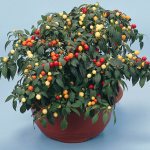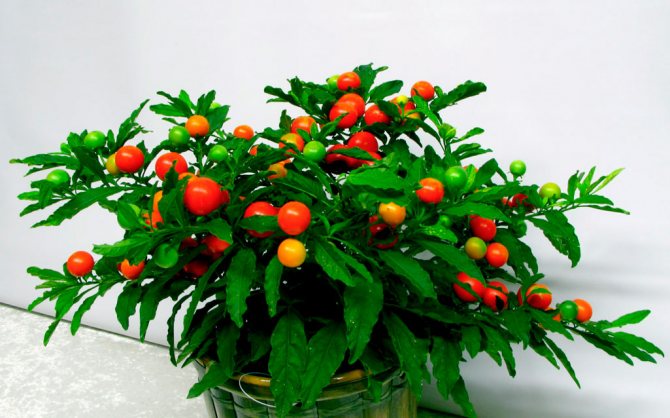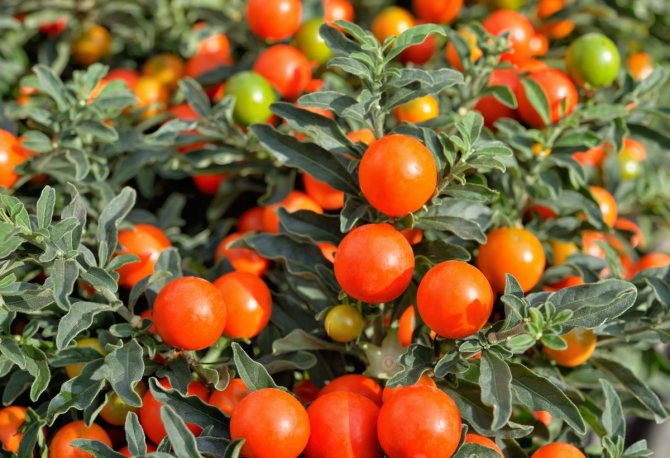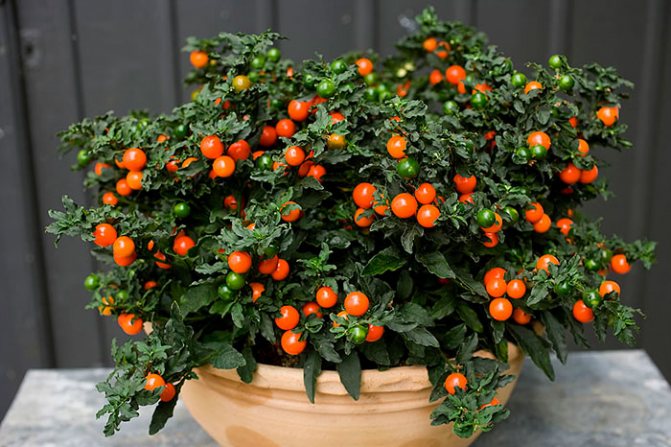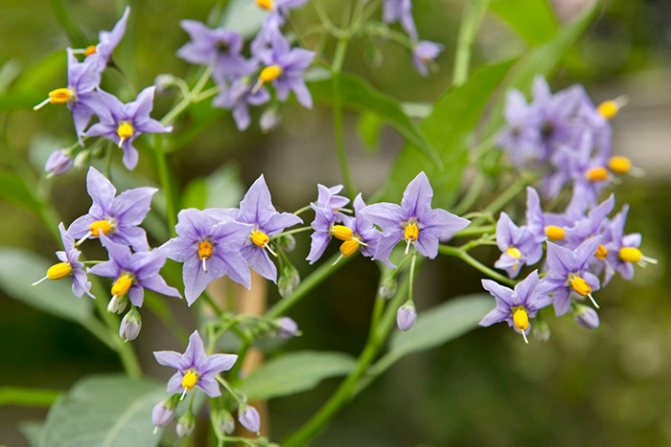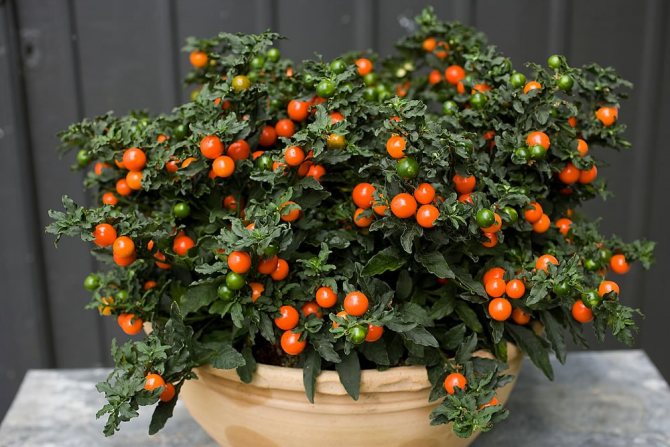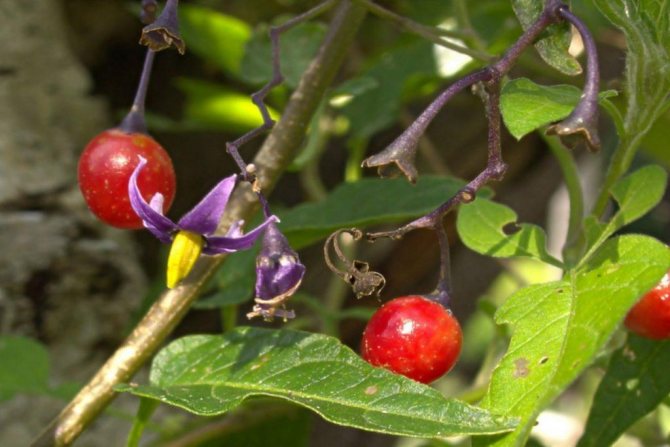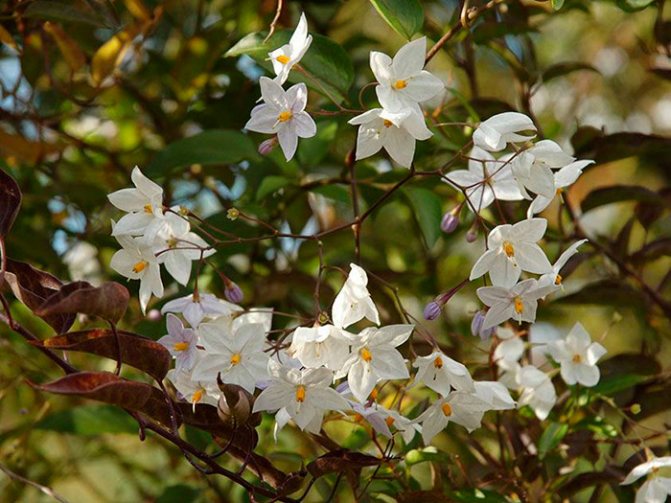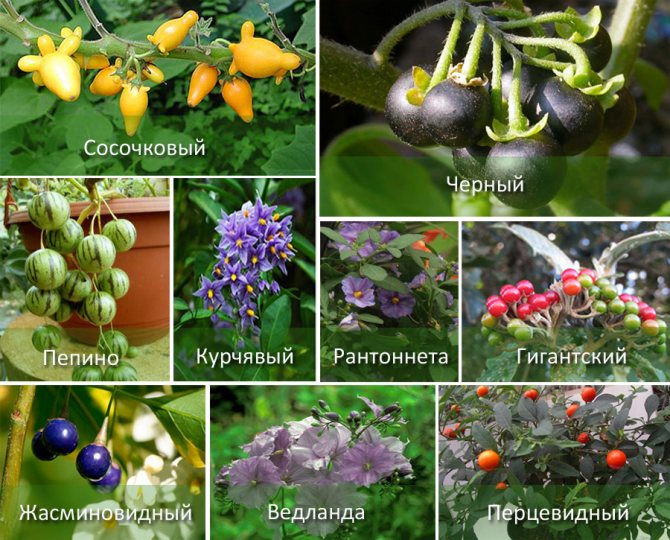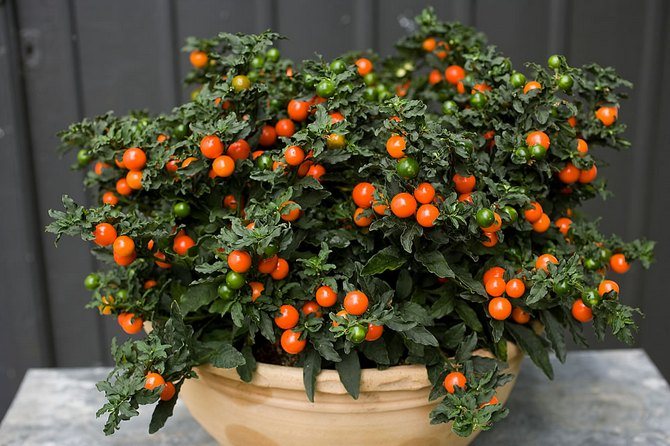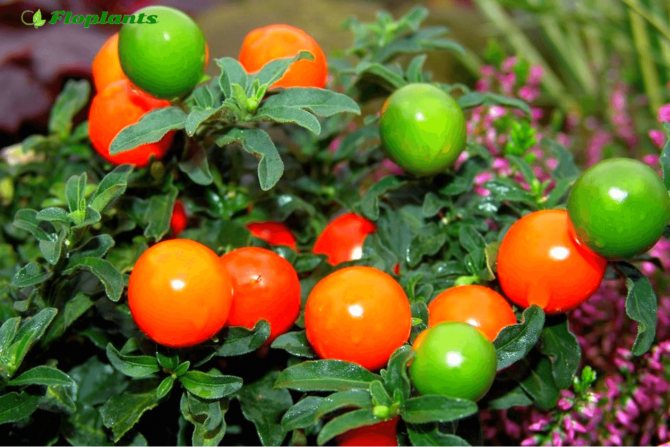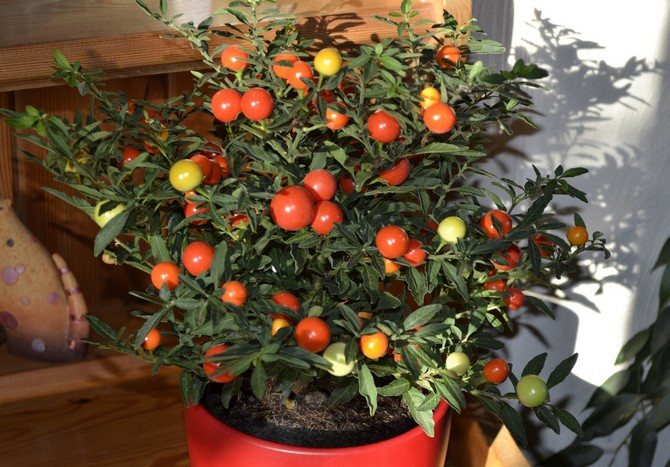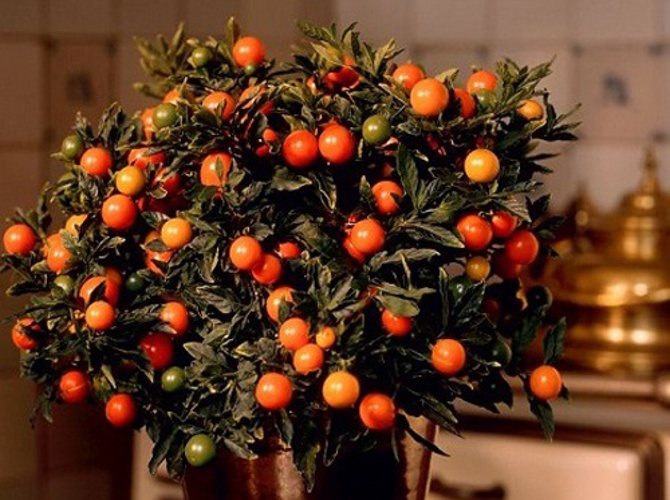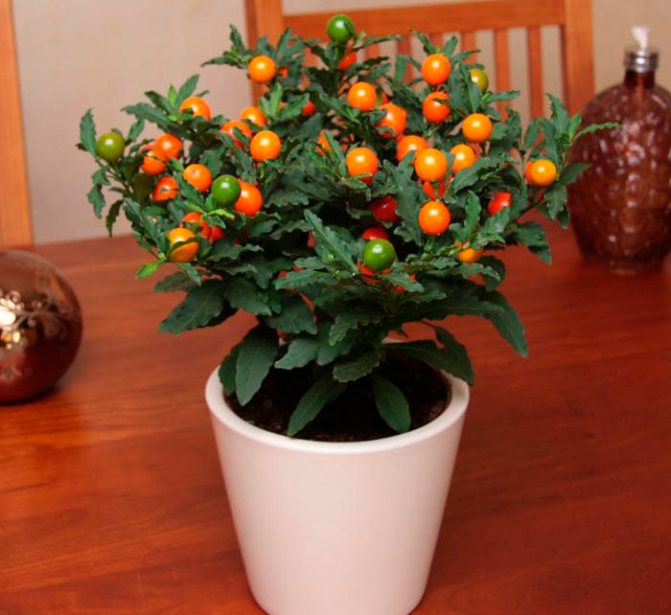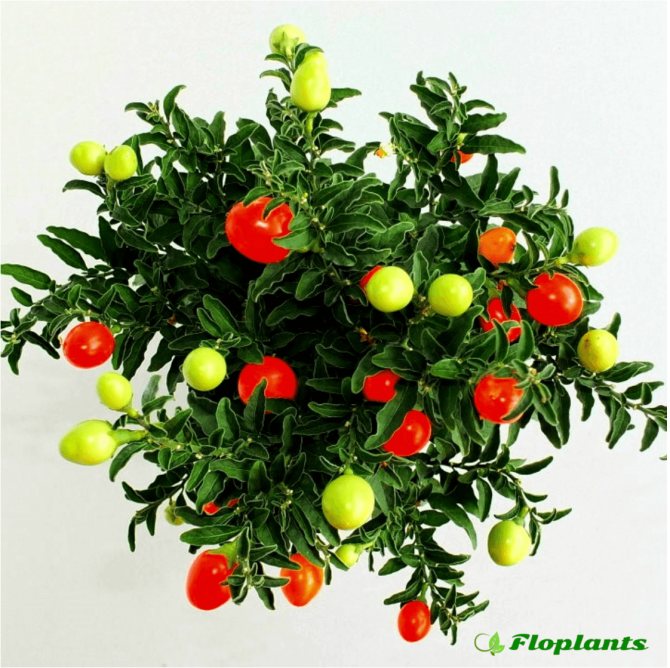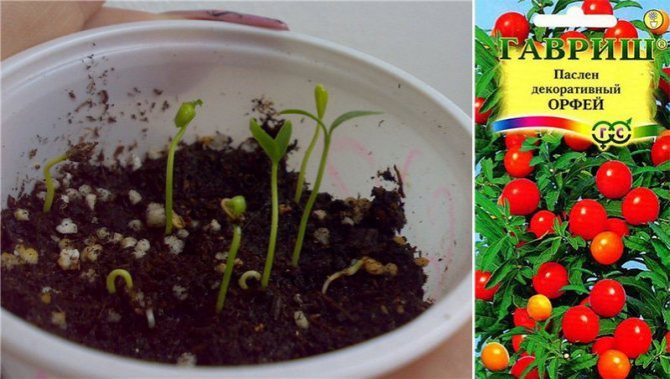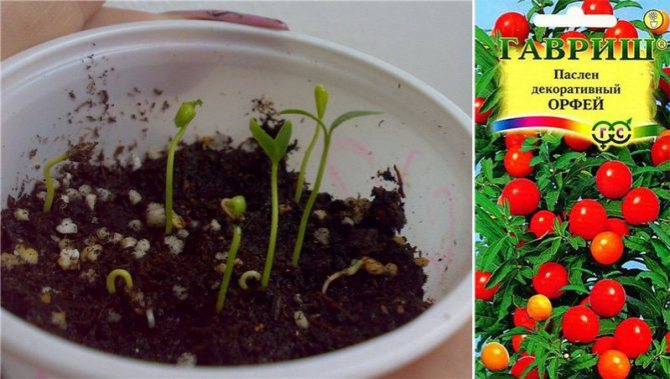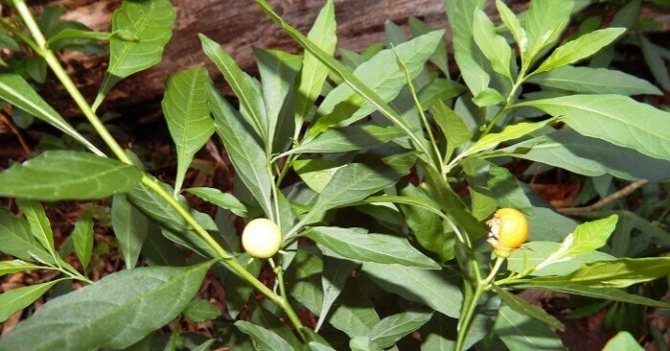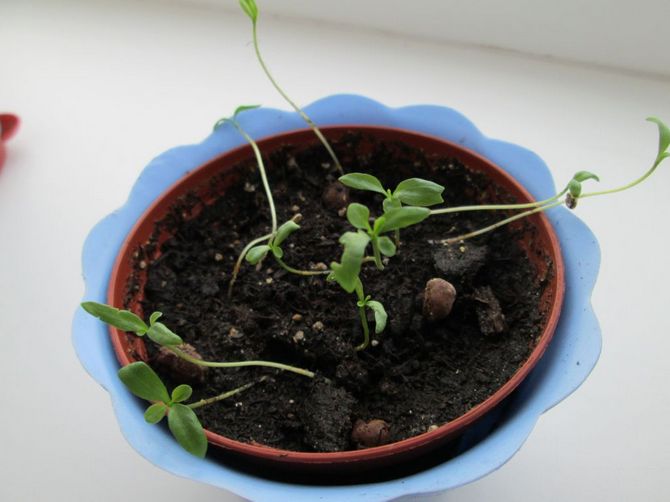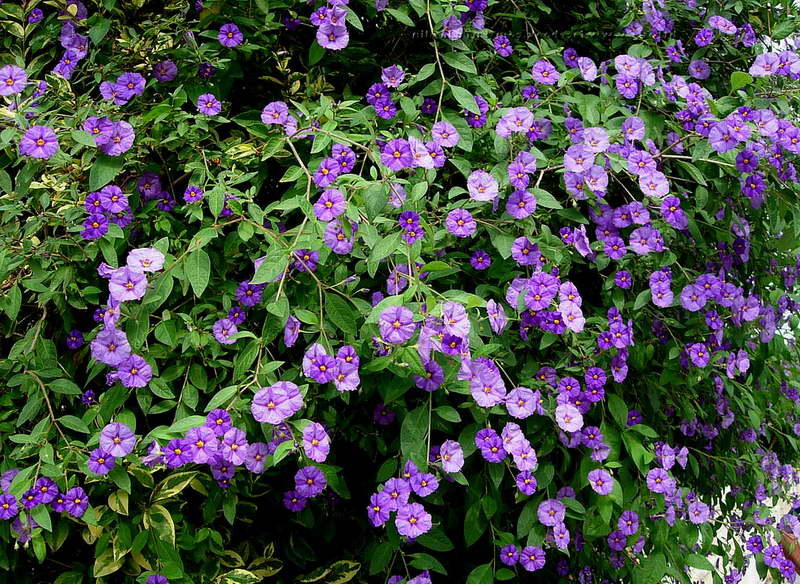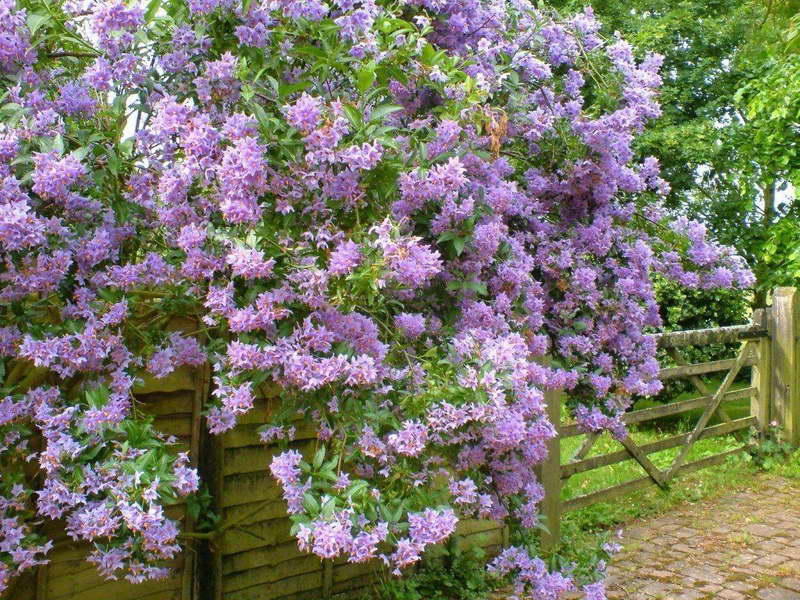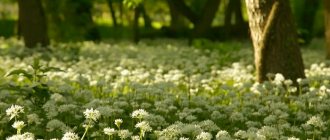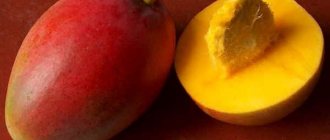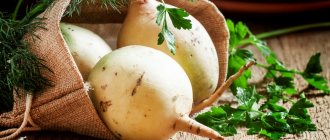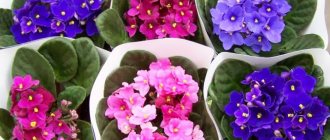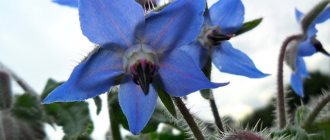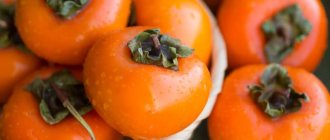Indoor nightshade (Solanum) belongs to a large genus of plants from the Solanaceae family, which contains approximately 1200 different species. These include well-known vegetable crops, for example: tomato, potato, decorative - curly, jasmine, and indoor - false pepper, pepper.
Indoor nightshade or solanum grows in warm climates, in areas of moderate heat. He owes this to his origin. Its homeland is considered to be the tropics and subtropics of Central and South America, South Asia.
The main types of indoor nightshade
There are many species of nightshade in nature, native to the rainforests of South America. Only a few of them are grown at home. This is explained by the certain exactingness of the indoor nightshade to care and growing conditions.
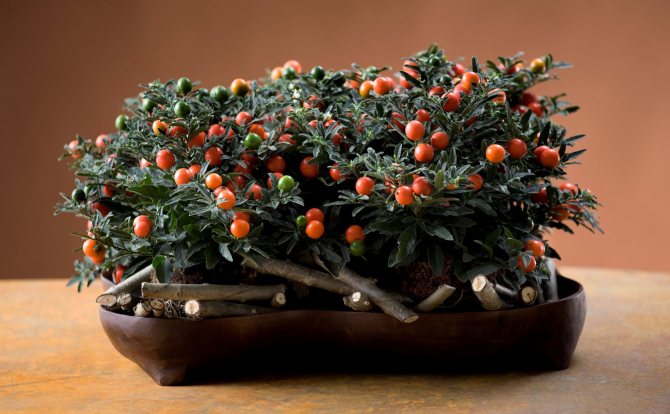
Solanum room
False nightshade
An evergreen shrub with erect shoots, reaching a height of 120 cm in its natural habitat.
Leaves are oval, with short petioles. White flowers, about 1 cm in diameter, are arranged singly or form small clusters.
Fruits are berry-shaped balls about 1 cm in diameter, when ripe they acquire an orange-red, sometimes yellow color.
Pepper nightshade
It is similar in appearance to pseudo-pepper nightshade, but has some excellent parameters:
- smaller size of the shrub itself;
- less lignification of shoots
- grayish edge on young shoots,
- smaller fruit size
- medicinal properties (helps in the treatment of angina).
For reference: popular varieties include Variegatum, which has a variegated leaf color, and Craigii, which can be white or red in color.
Yellow papillary nightshade
For the bright yellow fruits of an unusual shape, this variety is also called "cow's udder".
The shrub is covered with soft leaves that look like small burdocks. The stems are thick and prickly. The flowers are small, purple or white. In their place, fruits of yellow or orange color are formed.
Loose jasmine nightshade
Evergreen climbing liana - thin, smooth green shoots can reach a length of 2 meters. Leaves are ovate, slightly elongated, up to 7 cm long and up to 3 cm wide. Flowers are about 2 cm in diameter, light blue or almost white, collected in panicle inflorescences.
Flowering lasts from early spring to mid-autumn. The fruits are round berries 1.5 cm in size, coral-red in color.
There are many wild varieties of the plant, including the prickly nightshade, named after the needles growing on its roots and flowers. This variety causes serious harm to livestock and is considered a weed that can displace all herbaceous vegetation in places of natural growth.
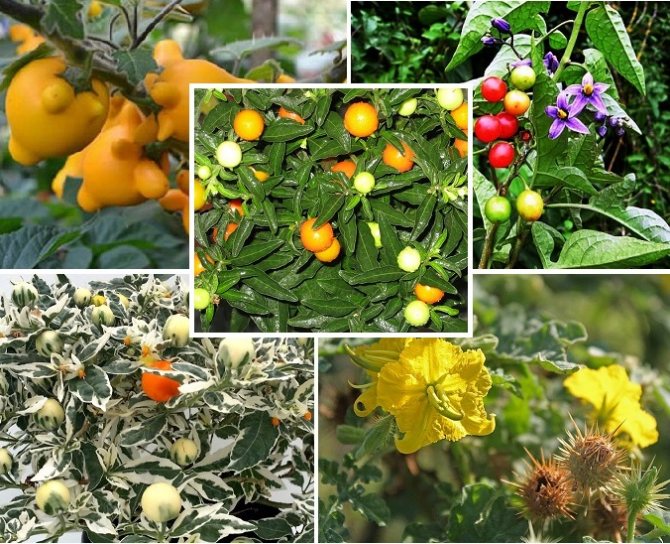

Varieties of nightshade
Vegetable crops
Hatiora 130 photos of a cactus, tips for care and reproduction at home. Plant transplant and watering rules
First, let's talk about delicious nightshades, that is, those that we are used to eating.
Tomato - saturated with glucose and fructose, proteins, organic acids, fiber, pectins, minerals. Useful for those who suffer from gastritis, anemia, cardiovascular diseases. It is widely used in cooking and as a dietary product.You can eat a vegetable raw, prepare various dishes, sauces from it, cook juice, canning. Vegetables are grown both outdoors and indoors. They love light and warmth, do not tolerate very humid air, but at the same time they require constant watering, as well as protection from the wind. The optimum acidity of the soil for tomatoes is 6-7 pH. Better they "live" in light soils.
Did you know? American colonists thought the tomato was poisonous. Colonel Robert Gibbon Johnson undertook to prove otherwise in 1820, emptying a bucket of tomatoes on the steps of a court in Salem, New Jersey. Since then, tomatoes have grown rapidly in popularity.
- Eggplants - they contain a lot of different minerals, vitamins, pectins, as well as potassium salts, which are needed for the heart muscle to function properly. The use of eggplant has a beneficial effect on the biliary tract, digestion, blood vessels, increases hemoglobin, the release of excess cholesterol. The vegetable can be fried, boiled, canned, dried, used for sauce, gravy, or caviar. It is grown, as a rule, by the seedling method. Eggplant seeds begin to grow at a temperature of at least + 15 ° C. A vegetable picks and transplants is difficult, so be attentive to it and be careful. Loose, light, well-fertilized soil is suitable for them. Eggplants love open, sunny areas.
Pepper - it contains a lot of vitamin C. In addition, it is saturated with vitamins P, A and group B, zinc, phosphorus, iron, iodine, and also capsaicin - the most useful alkaloid for digestion. We love to eat this vegetable raw, using it in various salads. It also makes delicious stews, gravies, sauces, you can canned it. Hot pepper is also used in medicine: medicines based on it are good for grinding, and pepper plasters are used for radiculitis, sprains, bruises, and neuralgia. It, like eggplants, is grown by seedlings, and planted in sunny, wind-protected areas. The land for this vegetable is prepared in the fall - it is cleaned, dug up and fertilized.
Potatoes - they contain a lot of vitamin C, complex carbohydrates, and fiber. The tubers contain up to 25% starch. This is one of the main sources of potassium for you and me. In addition to cooking (and there it is used very widely - it is boiled, fried, stewed, put in soups and turned into chips), potatoes are used to make alcohol, moreover, as the main raw material. The soil for potatoes should be loose. The vegetable is usually planted in late April or early May in good weather. For planting, as a rule, large beautiful tubers are selected. They are planted in holes dug in advance and covered with earth.
Of the vegetable crops, the nightshade family also includes: cherry tomatoes, Mazarin, Raketa, and green bell peppers
- Melon pear (sweet cucumber) - contains carotene, iron, vitamins of group B. It can be eaten raw, salted, made jams. This vegetable is propagated by seeds or cuttings. His homeland is South Africa. It is there that the vegetable "lives" best. Our plant can only be kept at home on a windowsill or in a heated greenhouse.
Physalis is predominantly found in South and Central America. He came to us along with the tomatoes, but he never received much recognition. Physalis fruits are pickled, pickled, make jam from them. True, physalis is usually grown by our summer residents as a decoration, and edible fruits can be found on the plots extremely rarely. They grow it under the sun in a fertile land. Tall species must be tied up. In order for the "lanterns" to ripen before the cold weather, at the end of summer it is necessary to pinch (remove) the tops of the shoots. Once every 7 years, the bush is divided and planted so that it does not degenerate.
Cocoon is a fertile shrub from South America. We grow it in houses or greenhouses, and even then it is extremely rare. Cocoon today remains exotic in our area.But if you still want to start breeding it, then you should look for seeds in specialized stores. It is advised to grow it in the same way as eggplant seedlings.
Home care conditions
Taking up the cultivation of nightshade as a houseplant, you need to create special conditions for it and properly care for the flower. This concerns the correct selection of soil mixtures, maintaining the temperature regime, adhering to the schedule of irrigation and dressing.
Temperature
Callistemon lemon: home care examples
During active growth and flowering, the room temperature should not exceed 20 ° C. Otherwise, the plant is at risk of being attacked by a spider mite, from which the home nightshade will wither and lose fruit.
With the onset of autumn, the temperature is lowered to 18 ° C, in winter the flower needs even more coolness - 10-16 ° C. Without cold wintering, solanum may not bloom in spring, which means it will not begin to bear fruit.
Top dressing
You need to start feeding a homemade nightshade flower from the very beginning of cultivation, when the seedlings rise to 10 cm in height.
During the growing season, the plant is fed at least once every 2 weeks, and sometimes more often, since the plant develops, blooms and bears fruit very actively. For this, universal complex compositions for flowering plants are used. Closer to autumn, the number of dressings is gradually reduced, reducing it to naught by winter.
Important! During the flowering period, nightshade must be treated with wide-spectrum insecticides to protect against pest infestations!
The soil
When replanting an indoor nightshade flower, use ready-made soil for flowering plants, although you can prepare the mixture yourself. For this, the following components are mixed in equal parts:
- garden land;
- peat;
- humus;
- coarse river sand.
In any case, the soil must be disinfected before use, protecting the shrub from various diseases.
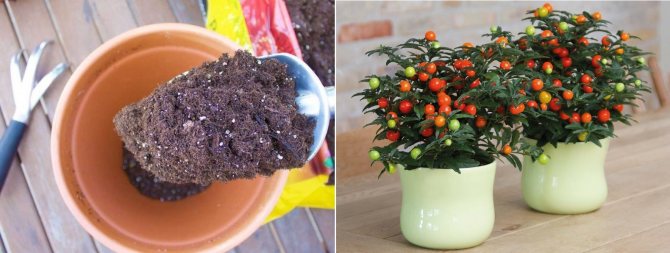

Soil preparation
Watering
Simultaneously with the rise in temperature after wintering, the number of waterings is gradually increased. A flower may react badly to a sharp change in the watering regime and discard foliage.
It is important to provide the most abundant moisture during flowering and fruiting, although you should not overdo it so that the roots do not rot. A prerequisite is the presence of a drainage layer in the bottom of the pot and holes for draining excess water. It is advisable to additionally spray nightshade during the summer months.
From November to spring warmth, the frequency of watering is reduced to a minimum, allowing the soil to dry well. The least moisture is required for the shrub in winter, during the dormant period.
Indoor cultivation
Indoor nightshade shows itself in all its glory in the autumn-winter period, therefore, it goes on sale at this time, along with cyclamen and poinsettia.
So that the plant does not lose its appearance after it is brought home, conditions should be provided that are close to natural.
- Lighting is required bright, but as in the lower part of the rainforest, diffused. South facing windows will not work. The nightshade will feel much better on the east or west side of the home. When grown on windows in the northern part, the bushes wither, lose leaves, bloom poorly and grow slowly.
- The temperature regime differs significantly in summer and winter. In the warm period, an increase of up to + 26 ° C is allowed. Keep it cool in winter. When the thermometer reads above + 14 ° C, leaves and fruits begin to fall off.
- Nightshade is an alien from the tropics, so it needs high humidity. To maintain the indicator at the proper level, spraying is regularly carried out, and containers with water are installed next to.
Providing the described maintenance regime, the plant will delight for a long time with the brightness of the fruits and the splendor of the bush.
Advice.For a massive ovary of berries, it is better to resort to artificial pollination. With a brush or feather, they transfer pollen from one flower to another.
Plant transplant
Vanilla orchid: the main types and options for home care
Ornamental nightshade is transplanted annually, immediately after wintering and before the onset of a period of active growth and flowering. At this time, the bush usually sheds fruits and leaves, and therefore it is easier to tolerate such manipulations.
The transplant is carried out by the transshipment method, trying to preserve the earthen lump and not disturb the roots. The pot is taken more than the previous one by 2-3 cm. The shoots are greatly shortened with sharply sharpened sterile scissors by about 1/3. With the beginning of the growing season, solanum will quickly recover.
Questions and answers
- What should be done to avoid the appearance of pests on indoor nightshade?


For preventive measures, foliage is treated with Decis and Phosbecid. It is recommended that you regularly shower with soap and water.
- Nightshade practically does not bear fruit, but the berries fall off immediately?
For long-term fruiting, it is necessary to create an environment with maximum humidity and good stable lighting, to maintain the temperature in winter from 16 to 18 degrees. In February, when the buds are laid, the bush is taken out to the balcony or outside, if the air temperature is not lower than 10 degrees. Fresh air will help the buds to form.
- Is the indoor nightshade poisonous or not?
Some types of indoor nightshade do have poisonous fruits and can cause poisoning. Therefore, it is better not to keep nightshade with poisonous berries in the house, if there are small children and pets in it, including birds.
Pruning nightshade
Planned flower pruning is carried out in the spring, simultaneously with the transplant. In addition, indoor nightshade requires a constant formative pinching of shoots, since it grows very quickly.
Reproduction of primrose: basic methods and examples at home
This procedure helps to give the bush the shape of a ball, which has a beneficial effect on its decorative qualities.
It is interesting! You can grow solanum in the form of a trunk. To do this, several young plants are planted in one common pot and, as they grow, remove the lower shoots, exposing the central ones and twisting them together.
Is homemade nightshade a danger?
Any part of the nightshade is poisonous. In no case should you eat berries. They taste unpleasant, bitter, but small children can eat them out of curiosity. Despite the fact that they most likely will not eat a large amount of these fruits, they will most likely have indigestion. And it also happened that the child swallowed the fetus whole or thrust it into the respiratory tract.
Indoor nightshade is a dangerous plant, and it is not advised to grow it in the apartment where there are small children, it would be better to wait until they grow up.
Fruiting
Nightshade looks very attractive almost all year round. The flowering period is gradually replaced by the formation of fruits, the bush is covered with glossy berries, which eventually acquire a bright orange color. After the fruits ripen and fall off, the plant begins to bloom again.
Whether the decorative nightshade begins to bloom and bear fruit at home depends on the care: air humidity, temperature conditions and sufficient watering. When the conditions are met, bud and fruit formation will be abundant.
If the number of cherry-like fruits is too small, then it is recommended to carry out artificial pollination of flowers in the next season.


Solanum blooming and covered with fruits
Insects - pests and diseases


Of the popular pests that can infect a plant, spider mites are isolated.Usually, this pest affects only the plant that is located in a too hot and dry room. For preventive purposes, it is necessary to ventilate the room from time to time and spray this bush from a spray bottle. To destroy the spider mite, it is necessary to treat the bush with an acaricidal agent.
If you take nightshade outdoors, it can also be attacked by pests. A pest such as aphids is very common for an open area. If a plant is damaged, it must be treated with insecticides.
Reproduction methods
The nightshade plant can be propagated by cuttings and sowing seeds. But it should be remembered that in the latter case, the young plant will later begin to bloom and bear fruit.
Propagation by cuttings
The procedure for propagating solanum by cuttings is usually combined with pruning and transplanting a flower.
The harvested shoots with an oblique bottom cut are placed in water with the addition of growth stimulants. The cuttings are kept in water until they give roots, after which they are planted in the ground.
It is allowed to immediately plant the nightshade cuttings in the ground, but then they need to provide greenhouse conditions by covering with a transparent glass jar or stretching the film.
Seed propagation
Having decided to germinate nightshade from seeds, sifted leafy soil is poured into a convenient container. The seeds are carefully scattered over the soil surface, covered with a 1 cm layer of sand on top. After that, they are carefully moistened by spraying, so as not to displace the seeds, and covered with glass.


Nightshade grown from seeds
A container with seedlings is placed in a room with an air temperature of about 22 ° C. The first shoots will appear after 2 weeks. As they grow, they dive, and later they are planted in separate pots.
Growing any ornamental plants requires attention, especially if they are tropical flowers. Strict adherence to the rules of care recommended by experienced growers for growing this indoor plant with bright red berries is important. Only in this case will it delight with lush flowering and an abundance of fruits.
Cuttings
An already existing adult nightshade bush can be successfully propagated vegetatively. For this purpose, several stem cuttings are cut from the plant or the tops of healthy shoots are taken from the plant after pruning. The material is planted for rooting in a seedling container with a peat-sand mixture (1: 1) or wet sand and placed in a warm place. When the cuttings acquire their own roots, they are "settled" in separate pots. A soil mixture for young bushes is prepared from humus, turf and sand (2: 1: 1). After transplanting, the cuttings are pinched to stimulate the development of lateral shoots.
Growing nightshade from seeds
Nightshade is very easy to propagate by seed. They are extracted from fully ripe, shriveled berries. Sowing starts in January. For this, a light substrate is prepared from a mixture of peat sand and vermiculite. Before sowing, the seeds are etched in a dark pink solution of potassium permanganate for 30 minutes.
In the future, this will protect the seedlings from fungal diseases.
Seeds germinate unevenly. The first shoots appear in 2 weeks, the last in 2 months. At the age of one month, the seedlings dive into separate containers. Young plants bloom in 6-7 months.
Useful properties and harmful qualities of black nightshade
Unripe berries are poisonous. The collected grass or flowers are dried in the shade, outdoors or indoors with normal ventilation, spreading in a thin layer on paper or cloth. Raw materials are stored in tightly closed jars separately from other medicinal plants. The shelf life of raw materials is 6 years. Berries are used fresh. The composition of the plant. Black nightshade herb contains glycoalkaloids (solacein, solanein), alkaloid solanine, solangoustine, saponins, tannins, asparagine, rutin, sitosterol, citric acid, carotene, vitamin C (25-180 mg%).Ripe berries contain anthocyanins, tannins, sugars, organic acids, vitamin C (up to 1600 mg%).
Medicinal properties, application, treatment. A decoction of black nightshade herb has sedative (calming), antispasmodic, diuretic, analgesic, expectorant, anthelmintic properties; mature fruits - antihypertensive, analgesic, anti-sclerotic, anthelmintic, mild laxative properties; flowers - diuretic, expectorant, analgesic properties. A decoction of the herb is prescribed for neuroses, headaches, spastic cough, bronchial asthma, spastic pain in the abdomen and bladder, gouty, rheumatic pain in the joints, with an irregular menstrual cycle, hemorrhoids. Fresh fruits of black nightshade will be indicated for hypertension, atherosclerosis, rheumatism, hemorrhoids, as a mild laxative, as an antihelminthic agent for children. Infusion of flowers is used as a diuretic, expectorant and for rheumatism. For skin diseases (eczema, psoriasis) powder of dried herb black nightshade is taken orally 3 times a day. The herb infusion is used externally in the form of washings and compresses for itchy eczema, psoriasis, and itching of the anus; with hemorrhoids - sitz baths. Fresh fruit juice diluted with water is used to rinse with sore throat, inflammatory diseases of the throat and oral cavity, with purulent diseases of the gums.
Dosage forms and doses. Decoction of black nightshade herb. 1 teaspoon of dry chopped herbs per 150 ml of water, boil over low heat for 10 minutes, remove from heat, filter after 1 hour. Take 1 teaspoon 2 times a day. The broth is stored in the refrigerator in a sealed glass container for no more than three days. This broth can also be used externally in the form of washings and compresses.
Black nightshade herb powder. Dried black nightshade herb is ground into powder in a coffee grinder. The grinder should then be washed thoroughly. 1/5 teaspoon of powder (0.1 g) is taken 3 times a day for skin diseases.
Fresh ripe fruits of black nightshade take 1 dessert spoon 2 times a day (6-8 grams daily dose) for hypertension and atherosclerosis.
Decoction of black nightshade fruit. 2 tablespoons of fresh ripe fruits in a glass of water, cook over low heat for 10 minutes, remove from heat, filter after 2 hours. The volume of the broth is brought with boiled water to the original (200 ml). Take a quarter of a glass of 4 rubles. per day for hemorrhoids, rheumatism, as well as a mild laxative.
Infusion of black nightshade flowers. 1 teaspoon of dry crushed flowers is poured with a glass of boiling water, insisted for 2 hours, filtered. Take 1 tablespoon 3-4 times a day as a diuretic, expectorant and for rheumatism.
Infusion of black nightshade herb for sitz baths. 8 tablespoons of dry chopped herbs are poured into 2 liters. boiling water, insist 4 hours, filter. The infusion is used for sitz baths for hemorrhoids.
Juice of fresh ripe black nightshade fruit. Mix 3 tablespoons of fruit juice with half a glass of warm boiled water. Apply as a rinse.
Warning. Since black nightshade is a poisonous plant, its preparations should be taken not for a very long time and observing the dosage.
List of medicinal plants
Medicinal and poisonous plants
Further we will talk about the representatives of this family, which are used both in folk and generally recognized medicine. True, despite this, they also have poisonous properties.
- Bittersweet nightshade (wolf berries) - its roots, leaves and stems are saturated with steroids, alkaloids, triterpenoids. It is used as an expectorant, anti-inflammatory, diuretic and choleretic agent, as well as for skin problems. Infusions are made from young stems and leaves (by the way, decoctions from them will destroy caterpillars and their larvae). Nightshade loves acidic lands with high humidity.He feels good even in the shade, he does not need much lighting, as well as shelter for the winter or any special conditions. The plant propagates by seeds and layering. Seeds are planted in open ground underground.
Belladonna (belladonna) - present in the composition of tablets, infusions, suppositories, drops. Has analgesic and antispasmodic properties. Recommended for ulcers, cholecystitis, Parkinson's disease, bronchial asthma. It is planted in low-lying areas with high humidity. The soil should be fertile, light or medium in composition so that air and water can penetrate into it without problems.
Did you know? The plant was given such a name not just. Indeed, from Italian "belladonna" is translated as "beautiful woman", namely the Italian seniors once dripped its juice into the eyes to make them shine and expressive. Belladonna berries were rubbed on the cheeks for a natural blush. Another name for the plant is mad berry. So it was named for the atropine, which is part of belladonna. He put a person in a state of extreme excitement.
- Black henbane - it contains potent alkaloids (scopolamine, atropine, hyoscyamine). Its oil is recommended for rheumatism, gout, bruises, and also as a pain reliever. In a small dosage, henbane medications are used as a sedative. By the way, henbane alkaloids are in Aeron tablets - from sea and airborne diseases. They grow it on fertile loose soils of a neutral reaction. Before planting, the seeds are stratified.
Datura ordinary - the alkaloid hyoscine is isolated from its leaves, which has a beneficial effect on the nervous system. They are also added to medicines for whooping cough and asthma because they have an antispasmodic effect. Datura is grown on loose, nutritious lands fertilized with ash. The plant is absolutely unpretentious.
Carnioli scopoly - its roots and rhizomes help with ailments of the eyes, liver, ulcers. By the way, earlier in folk medicine, the plant was used for rabies (inside). Scopolia prefers shade, an ideal place for it would be a site on the shore of a reservoir. The ground for it should be loose and moist. Watering is necessary regularly (especially during the hot period), but in moderation. Top dressing of scopolia is not needed, as well as a shelter for the winter.
Find out what useful properties vegetables have: cucumbers, onions (onions, red, shallots, chives, batun), zucchini, pumpkin, peas, cabbage (white cabbage, red cabbage, Savoyard, cauliflower, Beijing, Brussels sprouts, broccoli, kohlrabi, kale, pak -choy), beets.
- Mandragora is used in folk medicine: fresh root juice is good for rheumatism and gout, dry root is an analgesic for neuralgic and joint pains, digestive ailments, and the root rubbed and mixed with honey and milk is applied to tumors and edema. In our country, mandrake is often grown at home (for this it is better to take an autumn mandrake). It is planted in a tall flowerpot, with drainage laid out on the bottom. The soil should be loose. In summer, the plant is watered abundantly, but rarely in autumn and winter. In warm weather, the mandrake can be taken outside in a container, and in winter it only needs a warm room.
Tobacco - It contains nicotine, which is used in cigarettes and is highly addictive. Tincture of tobacco leaves is used for skin diseases and even oncology, juice is used to fight angina and malaria. Its leaves contain antibacterial substances, so tobacco dust is often used against diseases and pests that attack plants, and with cut tobacco leaves they fight moths. Tobacco is sown after black fallow or winter crops grown after black fallow in loose soil. Cannot be planted after beets and other nightshades.
Important! These plants are poisonous. They should be consumed wisely and only in small doses.
If you misuse them and then feel unwell, see your doctor right away!
The use of red nightshade in folk medicine
The healing properties of the above-ground and underground parts of the amazing plant make it possible to use it in recipes for home treatment:
- respiratory diseases (promotes expectoration);
- venereal and skin ailments caused by allergic reactions, eczema or various rashes;
- rheumatism;
- neuralgia;
- toothache;
- cardiac pathology;
- as a diuretic, diaphoretic and antihelminthic drug.
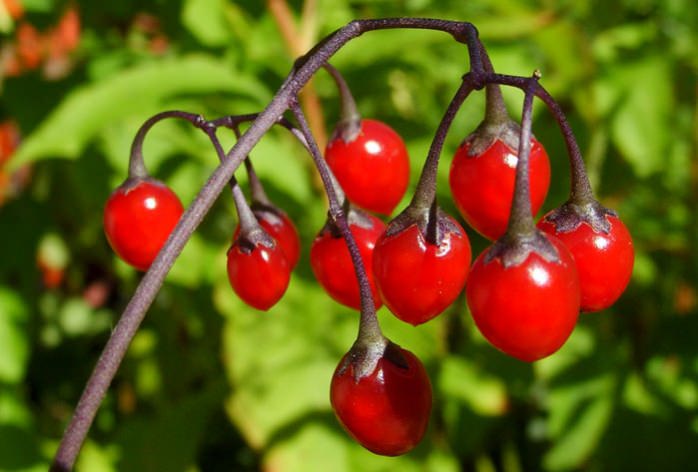

The berries taste initially sweet, and then become bitter.
Alcohol tincture of bittersweet nightshade
You can prepare the product yourself or purchase it at the pharmacy. It is required to take 40% alcohol in a ratio of 1: 5 and insist for a month. The tincture is recommended to be consumed during illness with viral infections and influenza. You should drink 10-30 drops 3 times a day. In addition, the drug is actively fighting the following ailments:
- hives;
- cleanses the blood and blood vessels;
- diarrhea;
- normalizes metabolic processes;
- diseases of the bladder and ureters.
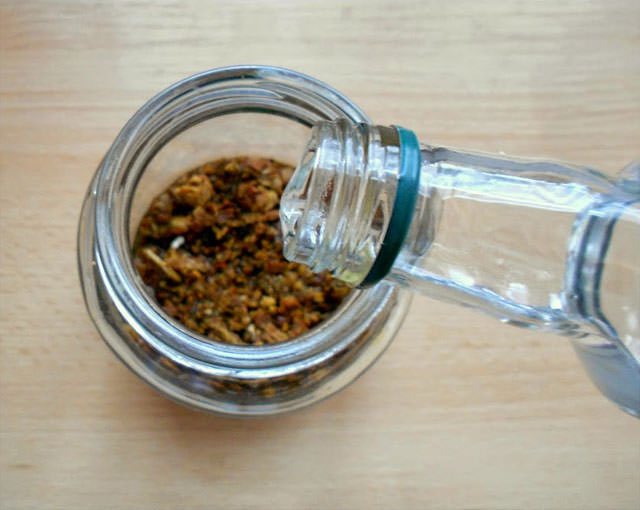

Alcohol tincture of bittersweet nightshade can be prepared by yourself
Recipes for infusions and decoctions of red nightshade
In the preparation of medicines, all parts of the plant are used, except for the rhizome.
- To prepare the infusion, pour boiling water (500 ml) with chopped flowers, stems and leaves (1 teaspoon from the mixture), insist for 4 hours. Drink 1 tablespoon before eating. Take the tops of the plant (1 teaspoon), add boiling water (500 ml). Filter after 1 hour.
- To get rid of pleurisy, prepare a decoction of 1 tablespoon of medicinal shrub leaves. Raw materials must be poured with water (500 ml) and simmer on the stove for 1 hour. Then squeeze the broth from the cake and drink 1 tablespoon three times a day.
- Infusion for expectoration. Combine nightshade, wild poppy flowers and sowing buckwheat - 30 g each, St. John's wort, mullein, malvia, white leaves - 40 g each, black elderberry, primrose, linden - 20 g each. 4 tablespoons of raw materials, stir in a liter of hot water and insist for hours.
- A drink for scrofula. You will need a tricolor violet with a succession (4 teaspoons of each) and 1 teaspoon of nightshade. Pour boiling water over a spoonful of herbs (250 ml) and leave for a couple of hours.
Features of black nightshade (video)
The broth can be used externally for skin diseases (rash, lichen, ulcers, abscesses). The tool is used in the form of washes, lotions and compresses.
Cooking bittersweet nightshade powder
To prepare the drug, it is necessary to collect the leaves of the plant, dry and grind to a powdery state. Ointments are prepared from the powder, or 0.5 g is taken twice a day.
Persons suffering from skin ailments need to take the crushed tops of the bush three times a day before eating at the tip of a knife and wash it down with water (one third of a glass).


Ancient healers recommended washing with nightshade decoction from a sad spirit
Crown formation and fruiting nightshade
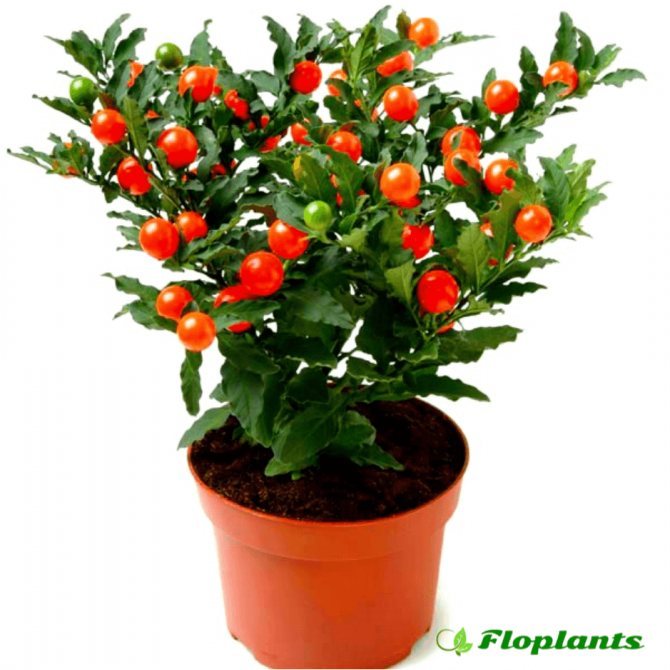

For the appearance of the fruits of nightshade, it is necessary to pollinate. If the shrub is kept outdoors during flowering, even the weakest wind can pollinate the plant. If flowering occurs indoors, manual pollination with a brush may be required.
Nightshade is pruned after flowering. It allows you to improve the general condition of the plant and increase its decorative effect. When pruning, the main stem must be shortened, this activates the lateral buds and stimulates branching. Each new side shoot is pinched.

